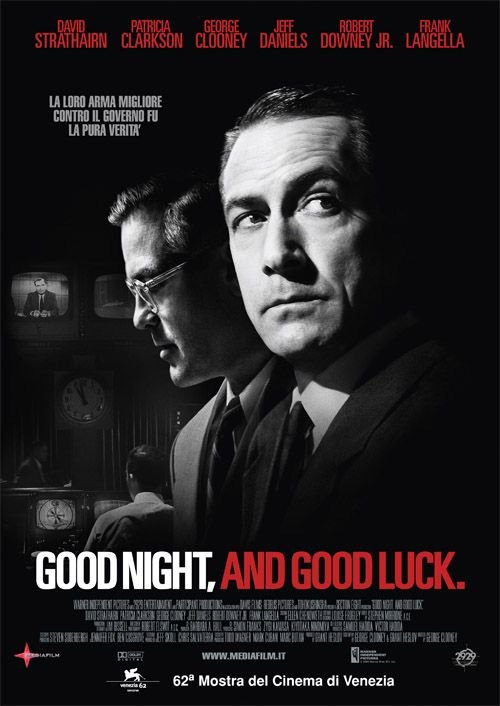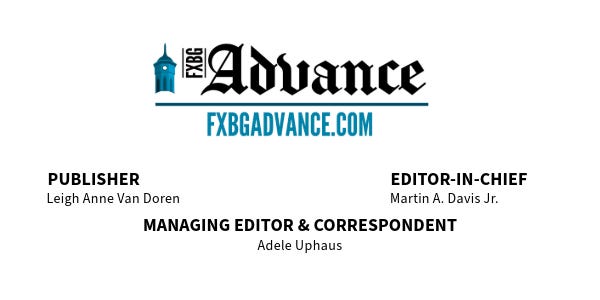Good Night, and Good Luck
A black and white homage to a new technology that helped journalism bring down a political thug.
By Alan Herrmann
FILM CRITIC

In 1953, America was engulfed in Communist fear by a Cold War with the Soviet Union and China. Since the end of World War II, anxiety over the possible use of nuclear weapons preyed on the American public as espionage became a major tool in stealing military secrets and recruiting turncoats.
As it often does, fear breeds contempt, irrationality, and pits citizen against citizen.
This was the case when Senator Joe McCarthy overstepped his bounds and accused thousands of Americans of being Communists, or, at the least, Communist sympathizers, with false and, often, no evidence. His mechanism was the House Un-American Activities Committee (HUAC) hearings that ruined the lives of many people, including politicians, writers, military personnel, and, of course, journalists. These hearings were broadcast on television, a relatively new form of entertainment and information that brought the visual news into the living room.
Fast forward to 2005, when actor-director and writer George Clooney makes one of his finest films, Good Night, and Good Luck. The film explores the true story of how Edward R. Murrow, Fred Friendly, and others at CBS, through their chosen medium of television, helped to bring down the demagogue, Joe McCarthy.
The film was a labor of love for Clooney who was a journalism major in college and whose father, Nick Clooney, was a TV newscaster. Clooney, on a very tight budget, paid himself next to nothing. He plays CBS producer Fred Friendly and recruits some of Hollywood’s finest, including David Strathairn (as Edward R. Murrow), Jeff Daniels, Patricia Clarkson, Robert Downey, Jr., and Frank Langella.
The true-to-life script follows the CBS news team that produced and broadcast Murrow’s brave decision to challenge the mudslinging and bullying of Senator Joe McCarthy as he continued to make false accusations about communist infiltrators.
In the film, Strathairn’s Murrow interviews McCarthy in a cleverly produced scene where footage of the real McCarthy is used instead of an actor portrayal. The story and interview are aired on Murrow’s You Are There news show, much to the chagrin of CBS heads who fear losing a major sponsor, Alcoa, that has several government contracts. It is seen as a victory for journalism, democracy, and the burgeoning use of television. But the program’s airing comes at a cost. Both Murrow and Friendly are taken down a few pegs by CBS top brass, causing Murrow to endure the humility of doing more fluff pieces like a home interview of Liberace.
The film, released in stunning black and white, feels very authentic—from the button-downed, well-groomed characters, to a precise recreation of the CBS studio and the large plumes of cigarette smoke wisping through scene after scene. This was not unusual in 1950’s America, where smoking was practically a national pastime. It’s as if the film leaps from the pages of Life magazine. Even the music score sung by the renowned jazz singer Dianne Reeves is spot on, with such standards of the time as “Straighten Up and Fly Right,” “How High the Moon,” and the lesser known, but significant, “TV is the Thing This Year.”
As with any new informative technology – the printing press, television, the internet – the promise of enlightenment is often fraught with abusers. Whether they are greedy CEOs, power-mad politicians, or con-artists – sometimes all three in one – there are still those who bravely challenge these abusers of power.
A free press and an informed voting public are still the best weapons we have in defending democracy. David Strathairn, beautifully channeling Edward R. Murrow, sums up his commentary about Joe McCarthy in this timeless warning:
“The actions of the junior Senator from Wisconsin have caused alarm and dismay amongst our allies abroad and given considerable comfort to our enemies. And whose fault is that? Not really his. He didn’t create this situation of fear; he merely exploited it – and rather successfully. Cassius was right. ‘The fault, dear Brutus, is not in our stars, but in ourselves.’ Good night, and good luck.”
Next weekend: An Academy Award-winning best picture for Veterans’ Day.
Local Obituaries
To view local obituaries or to send a note to family and loved ones, please visit the link that follows.
Support Award-winning, Locally Focused Journalism
The FXBG Advance cuts through the talking points to deliver both incisive and informative news about the issues, people, and organizations that daily affect your life. And we do it in a multi-partisan format that has no equal in this region. Over the past year, our reporting was:
First to report on a Spotsylvania School teacher arrested for bringing drugs onto campus.
First to report on new facility fees leveled by MWHC on patient bills.
First to detail controversial traffic numbers submitted by Stafford staff on the Buc-ee’s project
Provided extensive coverage of the cellphone bans that are sweeping local school districts.
And so much more, like Clay Jones, Drew Gallagher, Hank Silverberg, and more.
For just $8 a month, you can help support top-flight journalism that puts people over policies.
Your contributions 100% support our journalists.
Help us as we continue to grow!














One of my favorite movies. In addition to Strathairn's superb portrayal of Murrow, the whole feel of the movie took me back to the 1950s, Murrow and Cronkite on CBS, Huntley and Brinkley on NBC and Howard K. Smith on ABC, and being a child stringent the amazing invention in the living room.